Pesticide poisoning
| Pesticide toxicity | |
|---|---|
 |
|
| A sign warning about potential pesticide exposure. | |
| Classification and external resources | |
| Specialty | emergency medicine |
| ICD-10 | T60 |
| ICD-9-CM | 989.4 |
| MedlinePlus | 002430 |
| eMedicine | article/815051 |
A pesticide poisoning occurs when chemicals intended to control a pest affect non-target organisms such as humans, wildlife, or bees. There are three types of pesticide poisoning. The first of the three is a single and short-term very high level of exposure which can be experienced by individuals who commit suicide, as well as pesticide formulators. The second type of poisoning is long-term high-level exposure, which can occur in pesticide formulators and manufacturers. The third type of poisoning is a long-term low-level exposure, which individuals are exposed to from sources such as pesticide residues in food as well as contact with pesticide residues in the air, water, soil, sediment, food materials, plants and animals.
In developing countries, such as Sri Lanka, pesticide poisonings from short-term very high level of exposure (acute poisoning) is the most worrisome type of poisoning. However, in developed countries, such as Canada, it is the complete opposite: acute pesticide poisoning is controlled, thus making the main issue long-term low-level exposure of pesticides.
The most common exposure scenarios for pesticide-poisoning cases are accidental or suicidal poisonings, occupational exposure, by-stander exposure to off-target drift, and the general public who are exposed through environmental contamination.
Self-poisoning with agricultural pesticides represents a major hidden public health problem accounting for approximately one-third of all suicides worldwide. It is one of the most common forms of self-injury in the Global South. The World Health Organization estimates that 300,000 people die from self-harm each year in the Asia-Pacific region alone. Most cases of intentional pesticide poisoning appear to be impulsive acts undertaken during stressful events, and the availability of pesticides strongly influences the incidence of self poisoning. Pesticides are the agents most frequently used by farmers and students in India to commit suicide.
Pesticide poisoning is an important occupational health issue because pesticides are used in a large number of industries, which puts many different categories of workers at risk. Extensive use puts agricultural workers in particular at increased risk for pesticide illnesses. Workers in other industries are at risk for exposure as well. For example, commercial availability of pesticides in stores puts retail workers at risk for exposure and illness when they handle pesticide products. The ubiquity of pesticides puts emergency responders such as fire-fighters and police officers at risk, because they are often the first responders to emergency events and may be unaware of the presence of a poisoning hazard. The process of aircraft disinsection, in which pesticides are used on inbound international flights for insect and disease control, can also make flight attendants sick.
...
Wikipedia
